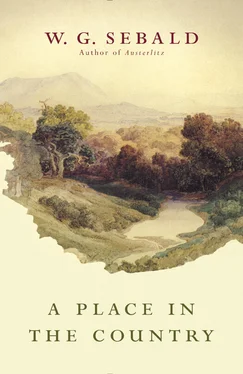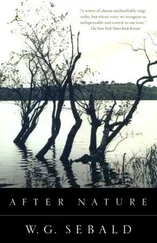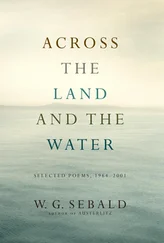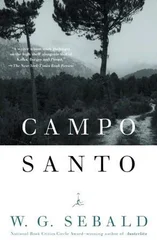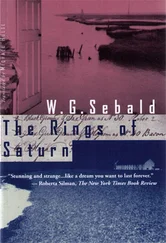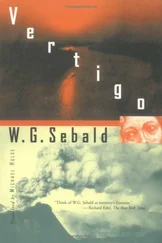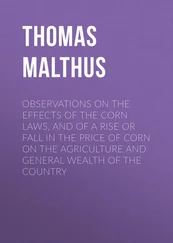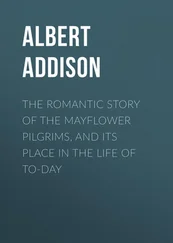Winfried Sebald - A Place in the Country
Здесь есть возможность читать онлайн «Winfried Sebald - A Place in the Country» весь текст электронной книги совершенно бесплатно (целиком полную версию без сокращений). В некоторых случаях можно слушать аудио, скачать через торрент в формате fb2 и присутствует краткое содержание. Год выпуска: 2013, Издательство: Hamish Hamilton, Жанр: Публицистика, Критика, на английском языке. Описание произведения, (предисловие) а так же отзывы посетителей доступны на портале библиотеки ЛибКат.
- Название:A Place in the Country
- Автор:
- Издательство:Hamish Hamilton
- Жанр:
- Год:2013
- ISBN:нет данных
- Рейтинг книги:3 / 5. Голосов: 1
-
Избранное:Добавить в избранное
- Отзывы:
-
Ваша оценка:
- 60
- 1
- 2
- 3
- 4
- 5
A Place in the Country: краткое содержание, описание и аннотация
Предлагаем к чтению аннотацию, описание, краткое содержание или предисловие (зависит от того, что написал сам автор книги «A Place in the Country»). Если вы не нашли необходимую информацию о книге — напишите в комментариях, мы постараемся отыскать её.
, he reflects on six of the figures who shaped him as a person and as a writer, including Jean-Jacques Rousseau, Robert Walser and Jan Peter Tripp.
Fusing biography and essay, and finding, as ever, inspiration in place — as when he journeys to the Ile St. Pierre, the tiny, lonely Swiss island where Jean-Jacques Rousseau found solace and inspiration — Sebald lovingly brings his subjects to life in his distinctive, inimitable voice.
A Place in the Country
A Place in the Country — читать онлайн бесплатно полную книгу (весь текст) целиком
Ниже представлен текст книги, разбитый по страницам. Система сохранения места последней прочитанной страницы, позволяет с удобством читать онлайн бесплатно книгу «A Place in the Country», без необходимости каждый раз заново искать на чём Вы остановились. Поставьте закладку, и сможете в любой момент перейти на страницу, на которой закончили чтение.
Интервал:
Закладка:


part of his admirers. Nor are the remarks which follow any exception, for since my first encounter with Walser I, too, have only ever been able to read him in an unsystematic fashion. Beginning now here and now there, for years I have been roaming around, now in the novels, now in the realms of the Bleistiftgebiet [Pencil Regions], and whenever I resume my intermittent reading of Walser’s writings, so, too, I always look again at the photographs we have of him, seven very different faces, stations in a life which hint at the silent catastrophe that has taken place between each. The pictures I am most familiar

with are those from his time in Herisau, showing Walser on one of his long walks, for there is something in the way that the poet, long since retired from the service of the pen, stands there in the landscape that reminds me instinctively of my grandfather, Josef Egelhofer, with whom as a child I often used to go for walks for hours at a time during those very same years, in a region which is in many ways similar to that

of Appenzell. When I look at these pictures of him on his walks, the cloth of Walser’s three-piece suit, the soft collar, the tiepin, the liver spots on the back of his hands, his neat salt-and-pepper mustache and the quiet expression in his eyes — each time, I think I see my grandfather before me. Yet it was not only in their appearance that my grandfather and Walser resembled each other, but also in their general bearing, something about the way each had of holding his hat in his hand, and the way that even in the finest weather, they would always carry an umbrella or a raincoat. For a long time I even imagined that my grandfather

shared with Walser the habit of leaving the top button of his waistcoat undone. Whether or not that was actually the case, it is a fact that both died in the same year, 1956—Walser, as is well known, on a walk he took on the twenty-fifth of December, and my grandfather on the fourteenth of April, the night before Walser’s last birthday, when it snowed once more even though spring was already under way. Perhaps that is the reason why now, when I think back to my grandfather’s death — to which I have never been able to reconcile myself — in my mind’s eye I always see him lying on the horn sledge on which Walser’s body, after he had been found in the snow and photographed, was taken back to the asylum. What is the significance of these similarities, overlaps, and coincidences? Are they rebuses of memory, delusions of the self and of the senses, or rather the schemes and symptoms of an order underlying the chaos of human relationships, and applying equally to the living and the dead, which lies beyond our comprehension? Carl Seelig relates that once, on a walk with Robert Walser, he had mentioned Paul Klee — they were just on the outskirts of the hamlet of Balgach — and scarcely had he uttered the name than he caught sight, as they entered the village, of a sign in an empty shop window bearing the words Paul Klee — Carver of Wooden Candlesticks . Seelig does not attempt to offer an explanation for the strange coincidence. He merely registers it, perhaps because it is precisely the most extraordinary things which are the most easily forgotten. And so I, too, will just set down without comment what happened to me recently while reading the novel Der Räuber [ The Robber ], the only one of Walser’s longer works with which I was at the time still unfamiliar. Quite near the beginning of the book the narrator states that the Robber crossed Lake Constance by moonlight. Exactly thus — by moonlight — is how, in one of my own stories, Aunt Fini imagines the young Ambros crossing the selfsame lake, although, as she makes a point of saying, this can scarcely have been the case in reality. Barely two pages farther on, the same story relates how, later, Ambros, while working as a room service waiter at the Savoy in London, made the acquaintance of a lady from Shanghai, about whom, however, Aunt Fini knows only that she had a taste for brown kid gloves and that, as Ambros once noted, she marked the beginning of his Trauerlaufbahn [career in mourning]. It is a similarly mysterious woman clad all in brown, and referred to by the narrator as the Henri Rousseau woman, whom the Robber meets, two pages on from the moonlit scene on Lake Constance, in a pale November wood — and nor is that all: a little later in the text, I know not from what depths, there appears the word Trauerlaufbahn , a term which I believed, when I wrote it down at the end of the Savoy episode, to be an invention entirely my own. I have always tried, in my own works, to mark my respect for those writers with whom I felt an affinity, to raise my hat to them, so to speak, by borrowing an attractive image or a few expressions, but it is one thing to set a marker in memory of a departed colleague, and quite another when one has the persistent feeling of being beckoned to from the other side.
Who and what Robert Walser really was is a question to which, despite my strangely close relationship with him, I am unable to give any reliable answer. The seven photographic portraits of him, as I have said, show very different people: a youth filled with a quiet sensuality; a young man hiding his anxieties as he prepares to make his way in bourgeois society; the heroic-looking writer of brooding aspect in Berlin; a thirty-seven-year-old with pale, watery-clear eyes; the Robber, smoking and dangerous-looking; a broken man; and finally the asylum inmate, completely destroyed and at the same time saved. What is striking about these portraits is not only how much they differ from each other, but also the palpable incongruity inherent in each — a feature which, I conjecture, stems at least in part from the contradiction between Walser’s native Swiss reserve and utter lack of conceit, and the anarchic, bohemian, and dandyesque tendencies which he displayed at the beginning of his career, and which he later hid, as far as possible, behind a façade of solid respectability. He himself relates how one Sunday he walked from Thun to Berne wearing a “louche pale-yellow summer suit and dancing pumps” and on his head a “deliberately dissolute, daring, ridiculous hat.” Sporting a cane, in Munich he promenades through the Englischer Garten to visit Wedekind, who shows a lively interest in his loud checked suit — quite a compliment, considering the extravagant fashions in vogue among the Schwabinger bohème at the time. He describes the walking outfit he wore on the long trek to Würzburg as having a “certain southern Italian appearance. It was a sort or species of suit in which I could have been seen to advantage in Naples. In reasonable, moderate Germany, however, it seemed to arouse more suspicion than confidence, more repulsion than attraction. How daring and fantastical I was at twenty-three!” A fondness for conspicuous costume and the dangers of indigence often go hand in hand. Hölderlin, too, is said to have had a definite penchant for fine clothes and appearance, so that his dilapidated aspect at the beginning of his breakdown was all the more alarming to his friends. Mächler recalls how Walser once visited his brother on the island of Rügen wearing threadbare and darned trousers, even though the latter had just made him a present of a brand-new suit, and in this context cites a passage of Die Geschwister Tanner [ The Tanners ] in which Simon is reproached by his sister thus: “For example, Simon, look at your trousers: All ragged at the bottom! To be sure, and I know this perfectly well myself: they’re just trousers, but trousers should be kept in just as good a condition as one’s soul, for when a person wears torn, ragged trousers it displays carelessness, and carelessness is an attribute of the soul. Your soul must be ragged too.” This reproach may well go back to remarks Lisa was at times wont to make about her brother’s appearance, but the inspired turn of phrase at the end — the reference to the ragged soul — that, I think, is an original aperçu on the part of the narrator, who is under no illusion as to how things stand with his inner life. Walser must at the time have hoped, through writing, to be able to escape the shadows which lay over his life from the beginning, and whose lengthening he anticipates at an early age, transforming them on the page from something very dense to something almost weightless. His ideal was to overcome the force of gravity. This is why he had no time for the grandiose tones in which the “dilettantes of the extreme left,” as he calls them, were in those days proclaiming the revolution in art. He is no Expressionist visionary prophesying the end of the world, but rather, as he says in the introduction to Fritz Kochers Aufsätze [Fritz Kocher’s Essays], a clairvoyant of the small. From his earliest attempts on, his natural inclination is for the most radical minimization and brevity, in other words the possibility of setting down a story in one fell swoop, without any deviation or hesitation. Walser shares this ambition with the Jugendstil artists, and like them he is also prone to the opposite tendency of losing himself in arabesques. The playful — and sometimes obsessive — working in with a fine brush of the most abstruse details is one of the most striking characteristics of Walser’s idiom. The word-eddies and turbulence created in the middle of a sentence by exaggerated participial constructions, or conglomerations of verbs such as haben helfen dürfen zu verhindern [have been able to help to prevent]; neologisms, such as for example das Manschettelige [cuffishness] or das Angstmeierliche [chicken-heartedness], which scuttle away under our gaze like millipedes; the “night-bird shyness, a flying-over-the-seas-in-the-dark, a soft inner whimpering” which, in a bold flight of metaphor, the narrator of The Robber claims hovers above one of Dürer’s female figures; deliberate curiosities such as the sofa “squeaching” [“ gyxelnd” ] under the charming weight of a seductive lady; the regionalisms, redolent of things long fallen into disuse; the almost manic loquaciousness — these are all elements in the painstaking process of elaboration Walser indulges in, out of a fear of reaching the end too quickly if — as is his inclination — he were to set down nothing but a beautifully curved line with no distracting branches or blossoms. Indeed, the detour is, for Walser, a matter of survival. “These detours I’m making serve the end of filling time, for I really must pull off a book of considerable length, otherwise I’ll be even more deeply despised than I am now.” On the other hand, however, it is precisely these linguistic montages — emerging as they do from the detours and digressions of narrative and, especially, of form — which are most at odds with the demands of high culture. Their associations with nonsense poetry and the word salad symptomatic of schizophasia were never likely to increase the market value of their author. And yet it is precisely his uniquely overwrought art of formulation which true readers would not be without for the world, for example in this passage from the Bleistiftgebiet which, comic and heartbreaking in equal measure, condenses a whole romantic melodrama into the space of a few lines. What Walser achieves here is the complete and utter subjection of the writer to the language, a pretense at awkwardness brought off with the utmost virtuosity, the perfect realization of that irony only ever hinted at by the German Romantics yet never achieved by any of them — with the possible exception of Hoffmann — in their writings. “In vain,” the passage in question tells us, regarding the beautiful Herta and her faithless Italian husband, “did she buy, in the finest first-class boutiques, for her most highly respected darling rake and pleasure-seeker, a new walking cane, say, or the finest and warmest coat which she could find, procure or purchase. His heart remained indifferent beneath the carefully chosen item of clothing and the hand hard which held the cane, and while this scoundrel — oh that we might be permitted to call him thus — frivolously flitted or flirted around, there trickled from those big tragic eyes, embellished by heartache with dark rims, heavy tears like pearls, and here we must remark, too, that the rooms where such intimate misfortune was played out were fairly brimming with gloomy, fantastically bepalmleaved decoration gilded further by the height and scale of the whole.” “Little sentence, little sentence”—so Walser concludes this escapade which is all but grammatically derailed by the end, “you seem to me phantastical as well, you do!” And then, coming down to earth, he adds the sober phrase, “But let us continue.”
Читать дальшеИнтервал:
Закладка:
Похожие книги на «A Place in the Country»
Представляем Вашему вниманию похожие книги на «A Place in the Country» списком для выбора. Мы отобрали схожую по названию и смыслу литературу в надежде предоставить читателям больше вариантов отыскать новые, интересные, ещё непрочитанные произведения.
Обсуждение, отзывы о книге «A Place in the Country» и просто собственные мнения читателей. Оставьте ваши комментарии, напишите, что Вы думаете о произведении, его смысле или главных героях. Укажите что конкретно понравилось, а что нет, и почему Вы так считаете.
